#white rumped vulture
Text
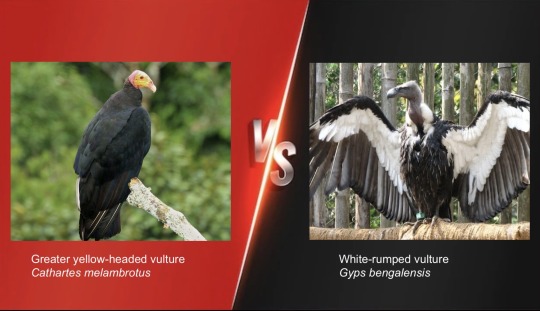
Our first New World vulture meets a classic Gyps!
The greater yellow-headed vulture, also known as the forest vulture, lives in wet, tropical forests in South America. They locate food by sight or their unusually developed sense of smell, but rely on larger scavengers like king vultures to open tough hides of carcasses. They have a wingspan of 1.66–1.78 m (65–70 in), and a weight averaging 1.65 kg (3.6 lb) Besides being larger, they have glossier feathers and a yellower face than the lesser yellow-headed vulture.
White-rumped vultures live in most environments in South Asia, though their range has been greatly reduced in recent decades. They nest and forage in flocks. A group of 100 of these vultures can strip a 100-pound carcass bare in 3 minutes! They weigh 3.5–7.5 kg (7.7–16.5 lb), have wingspans of 1.92–2.6 m (6.3–8.5 ft). Once they were the most numerous vulture in India, and possibly the most numerous large bird of prey in the world, but since 1980, their population has tragically declined from tens of millions to a mere 6,000. They are critically endangered due to diclofenac poisoning, a widespread problem known as the Indian Vulture Crisis.
218 notes
·
View notes
Text
YAYYY ITS THE FIRST SATURDAY OF SEPTEMER YOU KNOW WHAT THAT MEANSS

YAYYYYYY I LOVE VULTURESSS DID YOU KNOW NEW WORLD VULTURES AUCH AS TURKEY VULTURES AND BLACK VULTURE DONT HAVE A SYRINX/VOCAL ORGAN SO THE ONLY SOUNDS THEY MAKE ARE GRUNTS AND HISSES AND THEY SOUND SO COOL I LOVE VULTURESSSSS
#vulture#bearded vulture#turkey vulture#black vulture#ok the tags are going to get clogged because theres alot of vultures but here we go#cinereous vulture#griffon vulture#palm nut vulture#ruppells vulture#indian vulture#slender billed vulture#white backed vulture#cape vulture#hooded vulture#red headed vulture#loppet faced vulture#white headed vulture#egyptian vulture#himalyan vulture#white rumped vulture#lesser yellow headed vulture#california condor#andean condor#king vulture#vulture awarness day#ornithologist#ornithology#birds#zoology#avians
2 notes
·
View notes
Text
huge respect to @myxinidaes for reblogging that post with 100 birds
#ok im gonna try to list 100 birds. house sparrow song sparrow fox sparrow white-throated sparrow dark-eyed junco#robin. ovenbird. hermit thrush. carolina wren. cardinal#carolina chickadee. house finch. purple finch. goldfinch. white-breasted nuthatch#red-breasted nuthatch. hooded merganser. american coot. wood duck. mallard duck#surf scoter. ruddy duck. black duck. northern shoveler. common loon#crow. fish crow. raven. turkey vulture. bald eagle#feral pigeon. mourning dove. turkey. quail. AMERICAN WOODCOCK#solitary sandpiper. herring gull. great black-backed gull. piping plover. killdeer#yellow-rumped warbler. pine warbler. palm warbler. black and white warbler. i cant think of a fifth warbler. red tailed hawk#cooper's hawk. osprey. barn swallow. tree swallow. blue jay#peacock. egyptian goose. peregrine falcon. merlin. canadian goose#green heron. starting to struggle here. flamingo. skua. albatross. great blue heron#barn owl - snowy owl - great horned owl - barred owl - WHAT was that little owl in central park called - uhhh mandarin duck#chicken. california condor. rose finch (there are many but i dont remember any of the weirder species). adelie penguin. emperor penguin#northern mockingbird.. starling.. grackle.. african gray parrot.. monk parakeet#stellar's jay ... baltimore oriole.. argh what's the other oriole we get. DOWNY WOODPECKER.. hairy woodpecker... pileated woodpecker#red-headed woodpecker. red-bellied woodpecker. ruby-throated hummingbird. scarlet macaw. whooping crane#whippoorwill. snowy egret. great egret. european robin. bird of paradise#there's a warbler that's just 'yellow' right? yellow warbler? cormorant...#struggling with some where i cant remember the exact name like was it a 'double crested' cormorant or something else.#zebra finch .. blue-footed booby... pelican....#australian magpie. The Other Magpie. ibis (nonspecific). potoo. EASTERN BLUEBIRDDDDDD !!!#ceruleanrambling#now i can go read yours
17 notes
·
View notes
Text



White-Rumped Vulture
An illustration of the White-Rumped Vulture by John Gould and H. C. Richter, originally published in The Birds of Asia, Volume I (1850-1883).
Prints of this art are available on Redbubble.
Hi-res download of this art available on Ko-Fi.
0 notes
Photo
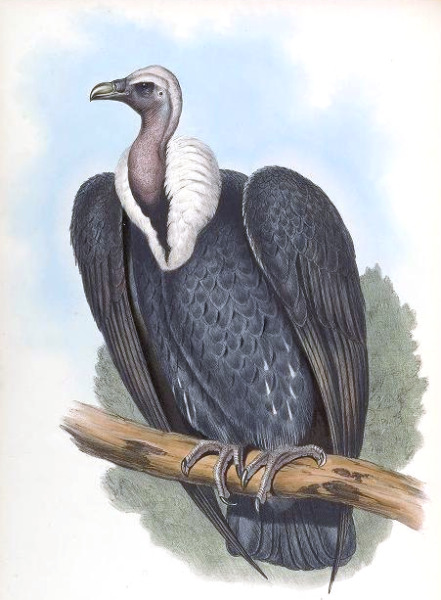
A new variant has been added!
White-rumped Vulture (Gyps bengalensis)
© Henry C. Richter
It hatches from brown, dark, distinctive, fine, juvenile, large, open, pale, silvery, and white eggs.
squawkoverflow - the ultimate bird collecting game
🥚 hatch ❤️ collect 🤝 connect
0 notes
Note
*smacks your door open like Shrek* FACTS ABOUT VULTURES, BRO?
A… VULTURE is a raptor
across the world adapted
to feed on diverse creatures once dead.
They can snack on carrion
pausing from aviation
to shine as pinnacle symbols of dread.
Well, these birds barf acid
and they digest rapid,
Circling a carcass even 'fore it goes flaccid.
But some will kill lambs just to eat their bones,
they scoop 'em up live and they drop 'em on stones.
Some have bald heads, some fly in fleets,
Some cool off by pissing on their feet.
Their stomach acid kills most disease,
As digitigrades they have funky knees.
Condor- That's a Vulture,
They're endangered, must breed.
Bearded- That's a Vulture,
They digest bones to feed.
There's species in new world and old,
They have feathers to protect from the cold.
In some legends, they can play the grim reaper.
Then in others, they can be your soul's keeper.
To Aztecs they meant rejuvenation,
In the Ramayana one had earned much veneration.
Some can use tools like rocks to break shells,
some can hunt well only using just smell,
some will dye their feathers with red blood,
without them most ecologies would go thud.
Turkey- That's a Vulture,
Turkey Vultures, I mean.
Buzzard- That's a Vulture,
They're endemic to Crete.
A feeding group is called a "wake,"
then when they're in flight, a "kettle" they make.
(Musical interlude and wet Vulture eating sounds sample)
Hooded- That's a Vulture,
They can nest in palm trees.
Griffon- That's a Vulture,
They're big on Halloween.
Dress as vultures to impress your friends,
They'll all miss the bird jokes when holidays end…
Some vultures lack notes-
There's no organ in their throats
that can make a chirp or caw or a squeak.
But, if they were to quote,
they would probly rather eat a goat,
that was already minced for their beak.
So, that's a vulture,
that's their avian culture.
Immortalized in paintings and immortalized in sculpture.
They're pretty cool birds and they sure look neat,
especially when dripping with rotting meat.
So help conserve and leave them be,
and adore them if they're in a tree.
Accipitridae or Cathartidae,
Enjoy them all and look at them fly!
White-Rump, that's a Vulture,
it is named for its butt.
Palm-nut, that's a Vulture,
it can feed on mollusks.
So that's all about this fine bird.
Go and fact check everything that you've just heard.
Yes, that's all about this great bird.
No go write about them, you absolute nerd.
#vulture#vultures#all-star#smash mouth#slight unreality#please anyone send me a message if you record this
370 notes
·
View notes
Text
I am on Spring break so I finally get to focus on birding again! Today's birds:
Little blue heron
Black vulture
Great egret
Sandhill crane
Mourning dove
Cattle egret
Great blue heron
Anhinga
Double crested cormorant
Red winged Blackbird
Limpkin
Wood stork
White ibis
Muskovy duck
Boat-tailed grackle
American crow
American coot
Common gallinule
Common grackle
Glossy ibis
Palm warbler
Common grackle
Osprey
American purple gallinule
Wood duck
Red shouldered hawk
Pied billed grebe
Royal tern
Eastern Phoebe
Roseate spoonbill
Black-bellied Whistling duck
Tricolor heron
Northern harrier
Yellow rumped warbler
Tree swallow
Swallow tailed kite
Ring billed gull
Turkey vulture
Little blue heron
Mallard
White pelican
Red eyed vireo
Mulard
Pekin x Mallard Hybrid (there was this fascinating flock of ducks consisting of mallards, feral pekins, muskovy ducks, mulards (muskovy x mallard hybrid), and Pekin/mallard hybrids)
Feral American pekin
99 notes
·
View notes
Note
if noah was actually written as the schemer, how do you think it would have gone exactly? love your writings btw
Thank you so much! And oh, anon. Anon you've unlocked character analysis mode. I hope you're ready for a bunch of paragraphs, because that's what you're getting.
First of all, as much as I love writing a Noah who can scheme on par with Alejandro or Heather, he's a different kind of schemer than them. Noah’s a lazy character at heart, particularly season 1 Noah. This is true whether or not you believe the theory that he sabotaged himself to get out of the game early. He’s a child who was born naturally smart. He hacked his way into moderating a forum at age 5 because he truly believed he could do a better job at it. He's going to believe in working smarter rather than harder.
Thus, his scheming reflects this. If Heather is a snake, and Alejandro is an eel, then Noah is a vulture. (Specifically a white-rumped vulture since its habitat as India. This isn't actually important to the narrative. But it's important to me to have animals that share the same roots as the characters they represent.) The bird has a reputation for being evil, but isn’t really. Noah’s more opportunistic than anything. He’s the type to let other people do all the hard work before swooping in for the kill.
His plan going into Island is to latch onto the strongest competitor and ride their coat tails. He'll stay in the middle of the pack for as long as possible. Once that's no longer an option, he'll commit to winning challenges to gain immunity.
Cue Heather. He can immediately recognize that she's one to take charge and sabotage. Which is perfect for him. He presents himself as an option for being her spy for the boys once he realizes she's looking for alliances (because I do rather like this direction that canon could have taken if they had committed to him being the schemer). He lets Heather take the lead, though does offer valuable suggestions based on his observations on the other contestants.
He also commits to getting close with Lindsay. He needs her to be more loyal to him than she is to Heather. He does this by indulging in her attempts to have them all be best alliance buddies. Babes, as she calls them. Noah tries arguing that there shouldn't be an 'e' in there, and also he's not a 'babe'. Heather and her, sure. But definitely not him. Lindsay refuses to listen to this logic because he's a part of the alliance, so he's a babe, and they can just give him a makeover if he's hung up on it!
Noah and Lindsay do end up becoming legitimate friends. The potential friendship of bimbo with a heart of gold and cold little cynic is just too much for me not to have them be friends. Schemer Noah still has a heart. And if he can have a friend and a shot at the prize money, then he'll take both. Besides, it's not like he's doing her any harm in trying to keep her completely from Heather's clutches.
All the while, he's making plans for eventually betraying Heather. He establishes early on that he has a 'journal' that's clearly a diary. It doesn't have anything in it, but no one else knows that. After a few episodes, he'll complain about it going missing. Not too long after, he'll be completely quiet about the matter.
See, Noah's patient. Once he's ready to drop Heather, he'll absolutely reveal the alliance. And he'll reveal that the only reason he was a part of it was because Heather stole his journal and threatened to read it to everyone just like she'd done to Gwen. It would immediately gain him sympathy points and paint a huge target on Heather's back that he'd coast by stress-free. And who are they going to believe? The girl who's been tormenting everyone from the beginning? Or the guy who hasn't been doing much?
Part of me wants to say he'd reveal this grand plan during/after Lindsay's elimination when it is suddenly very clear the alliance is over. Either way, his plan has worked, and now he can just coast on his sympathy until he's in the final three.
He still doesn't win the season. This is due to a combination of factors, centered around one thing: his overconfidence in his intelligence. He can make a plan, and he can execute it flawlessly. But he doesn't do so well at improvising, or thinking of what comes after.
He assumed that tossing Heather aside would see her focus her effort on winning and trying not to get eliminated. He underestimated how vindictive she would be, to the point of risking her own elimination to make sure Noah doesn't win, either. He also neglected to play the social game thanks to spending most of his time spying. Sure, he has their sympathy for being used by Heather. But most of them barely know him, and they'd rather protects their own friends than go out of their way to not eliminate Noah.
I don't know when exactly he'd be eliminated. It could be either before or after Heather, though I don't see him making it to the final three. I think final three is the farthest I'd be willing to put him, because there's no way he's not quitting on the dares before Owen or Gwen.
At the playa de losers, he has a bit of an existential crisis because this is the first time his intelligence hasn't just given something to him. Lindsay helps him through it in her own Lindsay way by serving as a reminder that she isn't smart, but she's still kicking! Plus, she was still able to tell Heather off, to which he would admit he was fairly impressed with the insults she threw down. He had no idea she had it in her.
He still manages to make friends with Izzy and Eva. This mainly happens during the special when all of a sudden there's a million on the line. He throws his lot in with two of the physically strongest competitors (who don't currently hate his guts), and accidentally makes more friends along the way. (I can never abandon Team E-scope).
When World Tour hits, he knows he has to force himself to be a more active participant. He knows he can't win the physical game, so he'll just have to, ugh, put effort into the social game. He still needs someone else to latch onto to help him with that, so he settles for Owen. He tells Owen that he's trying to be more 'friendly', and Owen's more than happy to take him under his wing! He's never really done that before! It'll be fun for both of them, he promises! (Nowen to some extent is also a constant in any of my ideas).
Meanwhile he also has to keep tabs on Alejandro. He sees the guy going after Team Victory one by one, but doesn't say anything because it's not his problem. ...Until he remembers that Lindsay is in Team Victory. So now he's got to scheme a way to get Alejandro to steer his attention away from Lindsay while also making sure Alejandro doesn't figure out who he's trying to protect.
It'll probably eventually lead to him and Heather teaming up against Alejandro as an 'enemy of my enemy' pact. Except Alejandro sees this and begins to tempt Noah to join his side as well. Everyone in the trio knows that the others are trying to take advantage of them. It's very much a Mexican standoff.
Aaaaand that's all I've got! I know Season 3 wasn't as detailed as Season 1 was, but I'm getting tired as I'm writing this reply due to the time I'm writing it. Also, the ideas have straight up run out for now, so time will tell what happens.
I hope you enjoyed reading this as much as I enjoyed writing it, anon!
#perp answers ask#total drama#td noah#total drama noah#schemer noah#td heather#td alejandro#td lindsay
75 notes
·
View notes
Text
In 2010 I illustrated the party game "Chimera Isle," by Kevin Lanzing which randomizes creatures from heads, bodies and tails, but for both convenience and fun I drew them together as complete creatures that would be split apart later, based on simple lists the creator sent me for "attributes" he wanted in the game; like a card that would make a creature the fastest, or the tallest, or a grazer or a scavenger.
The game went through some rules changes by the time it was released, and my real-life friends felt the unreleased beta rules were the easiest and most fun.
For $10 patreon patrons I've uploaded a zip of all the creatures in high resolution, an extensive text file detailing my conceptual rationale, and a PDF of what those original gameplay rules were like, but I'll also include a little bit of the art stuff right here:

"GRASS EATER head," "JUMPING body," "DEXTROUS" tail: Lanzing really liked my first concept for a grazer head, a goatlike animal with a lawnmower-like trunk. I reused his concept of spring-shaped legs for the "jumping" body, and then I assigned "dextrousness" as a tail piece with a cluster of tentacles, wielding a spear. I guess most people would expect dextrousness to be tied to the torso limbs, but this was approved for being unexpected and fun.
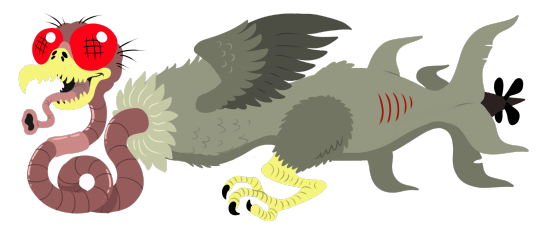
"SCAVENGER" head, "FLIGHT" body, "FASTEST" tail: for a scavenging creature I went all out with my personal tastes, making a vulture head that's also a fly head that's also a coiling earthworm, so the all-purpose "flight" body card became condor-like. Lanzing didn't assign attributes to body parts for me, but let me decide what should be what, so I made the "fastest" attribute a tail piece and designed it like a many-finned shark. This originally had a rocket jet on the end, but we changed it to a propeller because we already had a different fire-spewing tail.
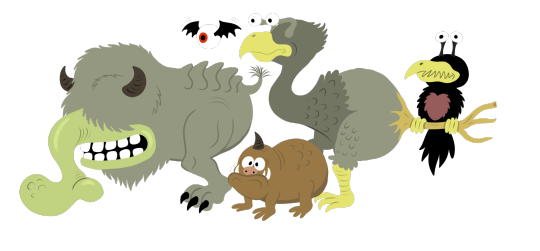
"SENSE OF SMELL" head, "SOCIAL" body, "SYMBIOTIC" tail: for sense of smell I designed a bison-like head with a huge, comical nose on the end of a little trunk and no visible eyes. Kevin's notes also included "SOCIAL" and "SYMBIOTIC" as two different attributes he wanted in the game, and they were the most fun to think of ideas for. I assigned "social" to a body card, and I drew it so whatever head card you drew, it would end in a little round rump with legs, with the rest of the body card featuring a band of different creatures: a little piglike thing, a flying eyeball, and a stalk-eyed flightless bird who leads into whatever tail card you drew. I then assigned "symbiotic" to a tail card resembling a tree branch with a little weird bird perched on it, and I decided to draw these three attributes together so they'd be a whole pack of creatures relying on a blind leader who sniffs out the food. Again these "original combinations" wouldn't be seen by players, so they're just my own internal behind-the-scenes combos.
I didn't include the following in the patreon file but if you're having a hard time picturing it here's how the Symbiosis Body card looks on its own, like all body cards still lining up with any possible head and tail:
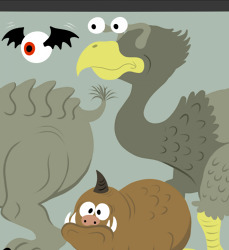
In retrospect, we settled on pretty bad background colors, the cool grey way too close to the dull green template of the creatures, especially given that they were done without any lineart. Should have gone with totally white backgrounds, but we thought that looked too cheap!
You can still buy chimera isle on the gamecrafter here, but I don't get royalties or anything, it was all one big commission, which did prove to be more money than I would have made off its sales!
121 notes
·
View notes
Text
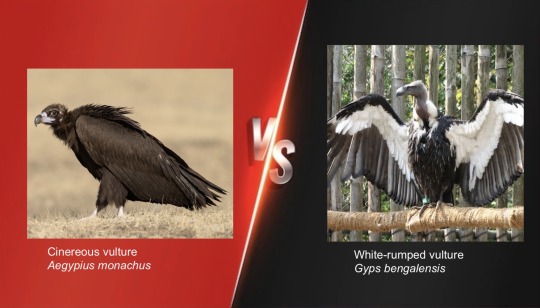
A powerful colossus vs Why You Shouldn’t Give Cattle Diclofenac
Cinereous vultures are the largest Old World vultures and the largest members of the Accipitridae family, with a wingspan of 2.5–3.1 m (8 ft 2 in – 10 ft 2 in) and weighing a whopping 6.3-14 kg (14-31 lb). They live across Eurasia, from Portugal to Iran to Korea, preferring dry, mountainous, open areas like steppes and shrublands at high elevations. They are largely solitary but may congregate in groups around large carcasses. Cinereous vultures mostly eat carrion but have also been recorded catching live prey. At carcasses, these vultures are dominant, able to fend off other scavengers including foxes, eagles, and other large vultures. As the strongest vultures in their range, they are often relied upon to tear open tough skin and break rib bones for access to carcasses. Also, the Hebrew word for “eagle” is also used for the cinereous vulture, meaning that references to eagles in the Bible could also be referring to cinereous vultures. They are classified as near threatened due to secondary poisoning.
White-rumped vultures live in most environments in South Asia, though their range has been greatly reduced in recent decades. They nest and forage in flocks. A group of 100 of these vultures can strip a 100-pound carcass bare in 3 minutes! They weigh 3.5–7.5 kg (7.7–16.5 lb), have wingspans of 1.92–2.6 m (6.3–8.5 ft). Once they were the most numerous vulture in India, and possibly the most numerous large bird of prey in the world, but since 1980, their population has tragically declined from tens of millions to a mere 6,000. They are critically endangered due to diclofenac poisoning, a widespread problem known as the Indian Vulture Crisis.
33 notes
·
View notes
Text
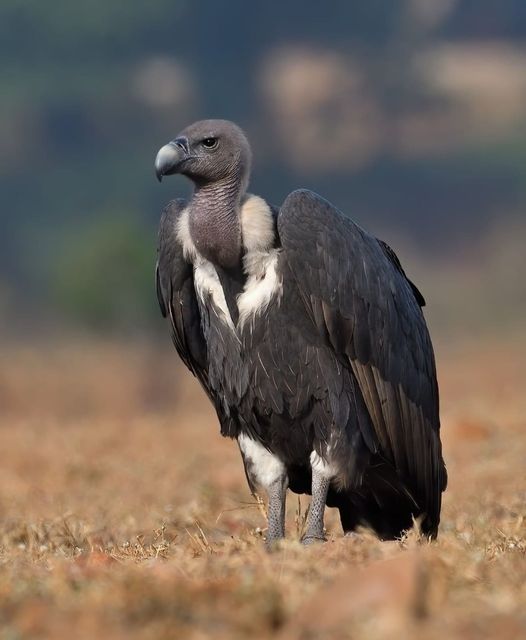
White-rumped Vulture (Gyps bengalensis), family Accipitridae, found in South and SE Asia
ENDANGERED.
photograph by @devkinandan_wildlifer
66 notes
·
View notes
Note
Do yu know what other animals were in ancient egypt? I want my oc to have a unique animal and you seem to know a fair amount

I am a well of ridiculous, hyperspecific, only interesting to some trivia lmao.
I would encourage you not to limit yourself to an entirely unique beast- many deities share sacred animals and are still strong individuals. My mind immediately goes to the huge number of feline deities- lions and lionesses in particular- for an example. Additionally, it's nigh impossible for me (with no academic anthropology/egyptology/historic zoology knowledge) to say for certain that particular animals were present in Kemet when they have no documented deities, mummies, or written mentions. I've had to guess for some, deduce by their present day habitats and more or less "timeline" of their species.
It's also important to keep in mind Kemet had contact with other civilizations in other habitats, meaning they were aware of animals not necessarily native to the area. A perfect example is the Hamadryas baboon- they were Nubian animals, but were sacred to both Thoth and Babi, depicted in art, and many mummies of the species have been recovered. A more surprising example is the Syrian brown bear, which was a rare exotic spectacle for the royal elite. There's also the trouble of many species now being extant from the area, meaning they were there but the local population is now extinct- the African sacred ibis is the example my mind comes to first, the waterfowl no longer present along the Nile.
Coincidentally, I've been compiling a list of animals for my own reference to supply a beast or two for the deities that don't have one in tradition.

Birds
Abdim's Stork
African Darter
African Dwarf Kingfisher
African Grass Owl
African Open-billed Stork
African Pied Wagtail
African Sacred Ibis
Asian Green Bee-Eater
Barbary Falcon
Barbary Partridge
Barn Owl
Barn Swallow
Bearded Vulture
Bennu Heron (likely not an actual animal, the Bennu bird inspired by the Goliath Heron- but felt like including it anyhow)
Black Kite
Black Stork
Black-throated Loon
Black-winged Kite
Brown-necked Raven
Carrion Crow
Cattle Egret
Chukar Partridge
Common Buzzard
Common Cormorant
Common Crane
Common Greenshank
Common House Martin
Common Kestrel
Common Kingfisher
Common Pochard
Common Quail
Common Raven
Common Redshank
Common Redstart
Common Sandpiper
Common Spoonbill
Common Teal
Crab Plover
Crested Plover
Dalmatian Pelican
Demoiselle Crane
Eagle (I'm sure there were some, but I can't find any definitive evidence of species in the ancient Kemetic culture- I would take a guess that the Golden Eage was an infrequent visitor)
Egyptian Plover
Egyptian Vulture
European Roller (considered a pest)
European Turtle-dove
Eurasian Coot
Eurasian Crag Martin
Eurasian Teal
Eurasian Wigeon
Fan-tailed Raven
Ferruginous Duck
Gadwall
Garganey
Glossy Ibis
Golden Oriole
Goliath Heron
Great Bittern
Great Bustard
Great Cormorant
Great Egret
Great Spotted Cuckoo
Great White Pelican
Greater Flamingo (possibly not native)
Green Sandpiper
Grey Heron
Griffon Vulture
Helmeted Guineafowl (not native)
Hermit Ibis
Hobby Falcon
Honey Buzzard
Hooded Crow
Hoopoe
Houbara Bustard
House Crow
House Sparrow (pest, hieroglyph had negative connotation)
Kittliz's Plover
Lanner Falcon
Lappet-faced Vulture
Laughing Dove
Lesser Kestrel
Lesser Pied Kingfisher
Little Bittern
Little Bustard
Little Egret
Little Owl
Long-eared Owl
Long-legged Buzzard
Mallard
Marabou Stork
Marsh Sandpiper
Masked Shrike
Merlin
Mourning Wheatear
Northern Lapwing
Northern Pintail
Northern Shoveler
Ostrich
Pale Crag Martin
Peregrine Falcon
Pied Avocet
Pink-backed Pelican
Purple Gallinule
Purple Heron
Red Kite
Red-backed Shrike
Red-footed Falcon
Red-rumped Wheatear
Reed Cormorant
Ring-necked Dove
Rock Dove
Rook
Ruddy Shelduck
Saddle-bill Stork
Saker Falcon
Sandhill Crane
Sand Martin
Sand Partridge
Short-eared Owl
Spotted Redshank
Sooty Falcon
Squacco Heron
Striated Heron
Swan (not native)
Tawny Owl
Tufted Duck
Western Reef Heron
White-backed Night Heron
White-crowned Wheatear
White Stork
White Wagtail
Wood Sandpiper
Yellow-billed Stork
Mammals
Aardvark (possibly not native)
Aardwolf
Addax Antelope
African Clawless Otter
African Giant Shrew
African Green Monkey (not native)
African Grass Rat
African Leopard
African Striped Weasel
Arabian Oryx
Barbary Deer (not native)
Barbary Lion (now extinct)
Barbary Macaque (not native)
Black Rat
Common Patas Monkey (not native)
Black Rhinoceros
Blanford's Fox
Black Wildebeest
Bubal Hartebeest (now extinct)
Cairo Spiny Mouse
Cape Hare
Caracal
Cheetah
Common Beisa Oryx
Common Genet
Desert Hedgehog
Desert Long-eared Bat
Dorcas Gazelle
Desert Black Cobra
Egyptian Fruit Bat
Egyptian Jackal/African Wolf (originally misidentified, now the African Wolf)
Egyptian Mongoose
Egyptian Pipistrelle
Egyptian Red Fox
Egyptian Slit-faced Bat
Egyptian Tomb Bat
Egyptian Weasel
Egyptian Wild Ass
Fennec Fox
Flower's Shrew
Four-toed Jerboa
Geoffroy's Horseshoe Bat
Gerenuk
Giraffe
Golden Spiny Mouse
Greater Egyptian Jerboa
Greater Mouse-tailed Bat
Greater Red Musk Shrew
Hamadryas Baboon (not native)
Hippopotamus
Honey Badger
House Mouse
Lesser Egyptian Jerboa
Lesser Mouse-tailed Bat
Long-eared Hedgehog
Long-nosed Shrew
North African/Bush Elephant (vilified and driven out by prehistoric Egyptians)
North African Crested Porcupine (not native)
Nubian Ibex (not native)
Olive Baboon (likely not native, sometimes called the Anubis Baboon)
Persian Fallow Deer (not native)
Rhim Gazelle
Rüppell's Fox
Sand Rat
Serval (likely not native, but Ra was depicted as one)
Scimitar Oryx
Soemmerring's Gazelle
Somali Dwarf Shrew
Spotted Hyena
Spotted-necked Otter
Striped Hyena
Syrian Brown Bear (not native)
Wild Boar
White Rhinoceros
Yellow Baboon (not native, species' epithet means 'dog-head' in Greek)
Vervet Monkey
Reptiles
African Chameleon
African Rock Python
Arabian Horned Viper
Desert Horned Viper
Desert Monitor Lizard
Egyptian Cobra
Egyptian Gecko
Egyptian Sand Boa
Egyptian Sand Racer
Egyptian Tortoise
Javelin Sand Boa
Insects/Arachnids/Etc.
Nile Crocodile
Nile Soft-shelled Turtle
Red Spitting Cobra
Saharan Sand Viper
Amphibians
African Common Toad
European Green Toad
Marsh Frog
Mascarene Grass Frog
Nile Delta Toad
Nile Valley Toad
Camel Spider
Banded Garden Spider
Brown Widow Spider
Carpenter Ant
Centipede
Click Beetle
Common Housefly (NOT considered a pest, actually revered as a protector)
Danaid Eggfly
Desert Ant
Desert Locust
Devil's Coach Horse Beetle
Dorippus Tiger Butterfly
Dragonfly
Flea
Fire Ant
Jewel Beetle
Gaudy Commodore Butterfly
Half-edged Wall Jumping Spider
Large Salmon Arab Butterfly
Maggot/Carrion Fly
Migratory Locust
Messor Ant
Millipede
Red-breasted Goose
Mosquito (pest)
Moths in the Saturniidae family
Palestine Yellow Scorpion
Pantropical Jumping Spider
Pharaoh Ant
Plain Tiger Butterfly
Praying Mantis
Scarab Beetle
Sinai Baton Blue Butterfly
Southern White Admiral Butterfly
Scorpions in the Buthidae and Scorpionidae families
Water Scorpion
Fish, Mollusks, etc. (Keep in mind fish were taboo in Kemet)
Abju
African Catfish
African Tigerfish
Bayad Fish
Blacktip Shark
Blue-spotted Stingray
Bolti
Chromis
Cichlid
Cornish Jack
Eel
Flatfish
Gilt-head Bream
Great Barracuda
Leopard Shark
Lepidotus Fish
Loligo Squid
Lungfish
Moon Fish
Mullet
Nile Barb
Nile Bichir
Nile Carp
Nile Mormyrid
Nile Labeo
Nile Perch
Nile Puffer
Parrotfish
Reef Manta Ray
Reef Shark
Sandbar Shark
Sea Snake
Scorpionfish
Spiny Lobster
Sturgeon
Surgeonfish
Swordfish
Thornback Ray
Thresher Shark
Tiger Shark
Tilapia
Triggerfish
Unicorn Fish
Wrasse
Zebra Shark
Domestic Animals
Bean Goose
Brant Goose
Camel (not introduced until Middle/New Kingdom)
Cats (Mau breed)
Chickens (not introduced until New Kingdom era)
Cow/Bull
Dogs (Saluki, Greyhound, Basenji, and Pharaoh Hound breeds)
Donkey
Egyptian Goose
Greater White-fronted Goose
Greylag Goose
Honey Bees
Horse (not introduced until New Kingdom)
Pig
Ram
My sources, if you're interested, are the Wikipedia page for Egyptian wildlife, a few different diving sites about the Mediterranean and Red Sea, a couple books I own on Ancient Egypt that describe the geography of the periods, and this lovely reddit multi-post
Sheep
13 notes
·
View notes
Text
Wingicide Time (Forcibly remove me into the ocean harder Hoppywoppy daddy)
Ancom- Pidgeon wings, qui seems like the kind of person to be borderline crustpunk.
Commie-Paragon Falcon
Ancap-Some kind of super fancy ultra luxury show bird, yknow them pigeons n shits that defy god and cost more than my entire college education
Nazi-Black eagle, my boyfriends gotta look cool!
Posadist-Xe gets dragonfly wings, or some other insect y'all can fill me in in the comments
Anarcho-Monarchist-Peacock! Or a bird of paradise
Anarcho-Primitivism- Yet another bird of paradise
Homonationalist- Black swan
Conservative-Angel!!! He gets a halo too, have fun in hell you sinners
Nazbol-Half bluejay half robbin
Trans Humanist- Think somewhere between a jetpack and Till Lindemann's flame wings
Progressive- Some kinda endangered species or other weak ass shit
Socialist- Nothing too revolutionary, something rose colored of course
Political Nihlism-King vulture
Libertarian- Snake,, snake wings?? Snake scale wings?? Dear google which bird eats snakes thanks
Minarchist- @flyingaceminarchist can kindly remind me what type, falcon I think?
Hoppean-Goose
Anarcho Fascism- bald eagle
Queer Anarchist-Hummingbird
Insan-Attack seagul
Anti-Radical-Butcher Bird
Horseshoe Centrist-Pegasus wings! Everyone knows they're real animals you silly goose!
Radical Centrist-Yet another bird of paradise
Ape political-No
Ingsoc-Black owl
Darwin-red tailed hawk
Communalist-Hen
Egoist-Whats the most vain bird?? All he knows is preen wings scream repeat
Ahospice-golden eagle
Cultcom-Grape scented wings, whats Guyana's national bird?
Censure-Tentacles count. [redacted]
Homosoc-A feather boa, fresh from pride
Ecofash-Eagle
Esofash-Chicken (if you know you know)
Church of Euthanasia-White rumped vulture
Acid Communism-Lesser blue eared starling
Everyone else I forgot-Fuck around and find out (this is an au where everyone has wings, not just hoppywoppy)
18 notes
·
View notes
Photo

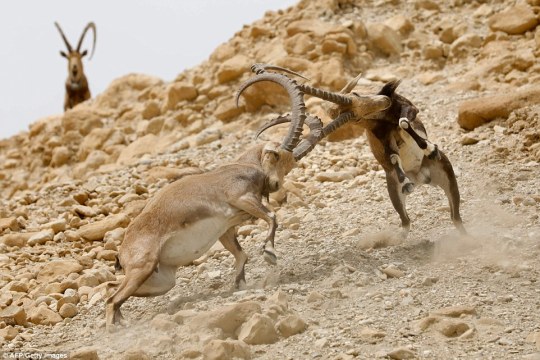
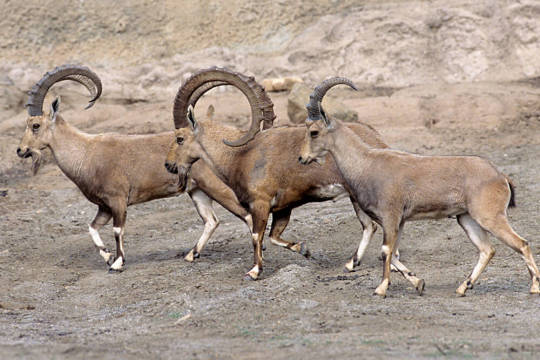


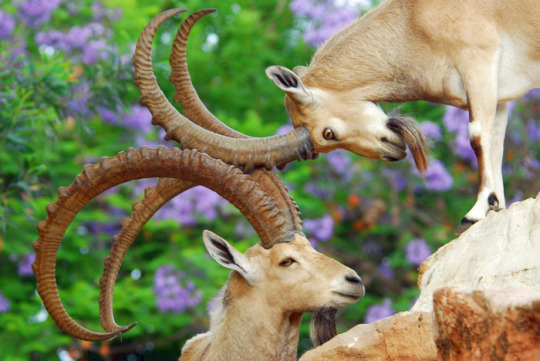

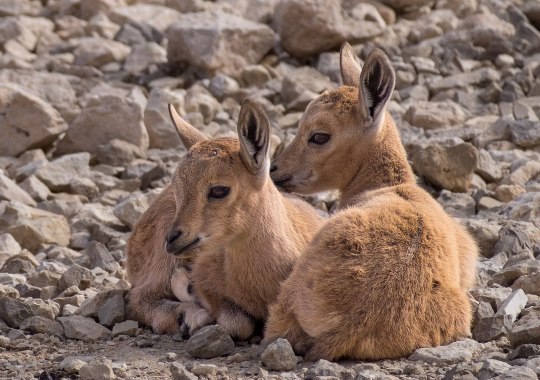
The Nubian ibex (Capra nubiana) is a desert-dwelling goat species (Genus Capra) which is native to mountainous regions of Northern Africa and the Middle East where it can be found throughout Egypt, Jordan, Oman, Israel, Palestine, Saudi Arabia, Ethiopia, Eritrea, Yemen, and Sudan. Nubian ibex are social animals that tend to live in sex segregated herds for much of the year, with females, young, and males up to the age of about three years living in groups of 20 -50 members. While adult males form herds of 8-10 which only merge with the female herds during the breeding season. Nubian ibex primarily feed upon grasses, shrubs, and the leaves of Acacia trees.They are preyed upon by leopards, wolves, golden jackals, foxes, eagles, and bearded vultures. With females averaging around 2ft ( 65cms) tall at the shoulder and 55-75lbs in weight, and males at 2.6ft (75cms) tall and 110 – 165lbs in weight, the nubian ibex is the smallest species of ibex on earth. They are a light tan color, with a white underbelly; males also have a dark brown mane down their backs. Their legs have a black and white pattern. They have a lighter rump with a dark brown tail. Males begin growing a beard at age 2 or 3, which continues to grow longer and darker as they age. Nubian ibexes have long, thin horns that extend up and then backwards and down, which get to around 1ft (30cms) in length for females and 3.3ft (1m) for males. Male horns are thicker and grow large bulges which prevent the horns from sliding while the males are locked in combat. The Mating season lasts through October and November, during which time male herds will join female herds and males will compete for the rank of dominate male in order to breed with receptive females. After a 5 month pregnancy mothers will typically give birth to 1-3 kids. The mother and young rejoin with other mothers to form and raise there young communally in crèches. Females reach sexually maturity at 3-4, while males reach it around 6. Under ideal conditions a Nubian ibex can live up to 18 years.
2 notes
·
View notes
Text
took myself off impromptu to one of the local nature reserves on thursday (despite it probably not being a good idea since the rolling black outs often mean no cell phone signal which means. no way of getting home) and w o w did i see a lot
TWO different kinds of duiker, which i haven't seen there in years thanks to local dogs killing them (common grey duiker and a group of blue duiker who hadn't heard that they're supposed to be shy), brown-backed honeybird (!), tambourine dove, sombre + yellow-bellied greenbul (!), palmnut vulture flying overhead (!), southern tchagra (!), cape + chinspot batis, black saw-wing (!), golden-tailed woodpecker, african paradise + african dusky + southern black flycatcher, terrestrial brownbul, green-backed camaroptera, tawny-flanked prinia, red-capped robin-chat, white-browed scrub-robin (!), amethyst + collared sunbird, neddicky, grey waxbill (!), golden-breasted bunting (!), yellow-throated longclaw (!), red-backed mannikin, yellow-fronted canary and the usuals (speckled mousebird, purple-crested turaco, red-eyed dove, fork-tailed drongo, bulbul etc etc). also heard bar-throated apalis, olive sunbird, black-collared barbet, golden-rumped tinkerbarbet, crowned eagle and black-headed oriole.
no new ticks, but two confirmed ticks of the black saw-wings (flitting about on the forests edge) and finally a confirmed visual of the yellow-bellied greenbul. very excited to see the palmnut vulture. grey waxbill was nice too, since i've only seen it once before, and the brown-backed honeybird was only my third sighting. didn't get any photos, i ran out of memory before i'd even left the forest area lol. overall 46 species including calls, which isn't bad for two hours in the afternoon
#on birds#confirmed ticks means i have this ticked off but i have literally no recollection of it/it might not have possibly been that but i was a#zealous child#or i've heard the bird and i've seen brief glimpses but never enough to be confident in ticking it off#also a....lot of domestic rabbits which is concerning#diary
8 notes
·
View notes
Text
I guess it's time I share my list of birds from this past Jewish year (I've been keeping two Big Year lists, Jewish year and secular year). All are from the US, except the last few which are indicated.
1. Ruby-crowned kinglet
2. American Robin
* Leucistic American Robin
3. Song sparrow
4. Rock pigeon
* Melanistic rock pigeon
5. Chipping sparrow
6. Hairy woodpecker
7. Mourning dove
8. Northern flicker
9. Eastern towhee
10. White crowned sparrow
11. White-throated sparrow
12 Savannah sparrow
13. House sparrow
14. European starling
15. American Crow
16. Common Raven
17. Gray catbird
18. Northern mockingbird
19. Canada Goose
20. Spotted Sandpiper
21. American herring gull
22. Marsh wren
23. Limpkin
24. Great white heron
25. Cattle egret
26. Anhinga
27. Snowy egret
28. Great blue heron
29. Black-crowned night heron
30. Wood stork
31. Common gallinule
32. Blue-gray gnatcatcher
33. Turkey vulture
34. Black vulture
35. Yellow rumped warbler
36. Tufted titmouse
37. Little blue heron
38. White ibis
39. Cooper's hawk
40. Cardinal
41. Green heron
42. Carolina wren
43. Palm warbler
44. Pine warbler
45. Sandhill crane
46. Carolina chickadee
47. Bluejay
48. Osprey
49. Chimney swift
50. Red-tailed hawk
51. Prairie warbler
52. American kestrel
53. Glossy ibis
54. Pied-billed grebe
55. Double-crested cormorant
56. Grey kingbird
57. Brown pelican
58. Fish crow
59. Royal tern
60. Bald eagle
61. Painted bunting
62. American white pelican
63. Common grackle
64. Boat-tailed grackle
65. Great-tailed grackle
66. American purple gallinule
67. American coot
68. Brown-headed cowbird
69. Tricolored heron
70. Mallard
71. Black-bellied whistling duck
72. Eastern kingbird
73. Yellow-billed cuckoo
74. Muscovy duck
75. American bittern
76. Ring-billed gull
77. American Pekin
78. Mallard-Pekin hybrid
79. Eastern bluebird
80. Yellow-bellied sapsucker
81. Red-winged blackbird
82. White-eyed vireo
83. Mottled duck
84. Broad-winged hawk
85. Dark-eyed junco
86. Brown thrasher
87. Sharp-shinned hawk
88. House finch
89. Eastern Phoebe
90. Downy woodpecker
91. Fox sparrow
92. Loggerhead Shrike!!!!
93. White breasted nuthatch
94. Red-bellied woodpecker
95. Brown creeper
96. Pileated woodpecker
97. American goldfinch
98. House wren
99. Barn swallow
100. Tree swallow
101. Black and white warbler
102. Red eyed vireo
103. Yellow warbler
104. Mute swan
105. Rusty blackbird
106. Common yellowthroat
107. Warbling vireo
108. Northern waterthrush
109. Veery
110. Swamp sparrow
111. Wood duck
112. American redstart
113. Orchard oriole
114. Greater Yellowlegs
115. Lesser Yellowlegs
116. Baltimore oriole
117. Hermit thrush
118. Wood thrush
119. Ovenbird
120. Indigo bunting
121. Black-throated blue warbler
122. Scarlet tanager
123. Worm-eating warbler
124. Northern rough-winged swallow
125. Blue-headed vireo
126. Northern parula
127. Prothonotary warbler
128. Philadelphia vireo
129. Blackburnian warbler
130. Magnolia warbler
131. Cedar waxwing
132. Blackpoll warbler
133. Yellow-throated vireo
134. Eastern wood pewee
135. Acadian flycatcher
136. Tennessee warbler
137. Caspian tern
138. Laughing gull
139. Forster's tern
140. American oystercatcher
141. Green-winged teal
142. Purple Martin
143. Least tern
144. Field sparrow
145. Killdeer
146. Grey-cheeked thrush
147. Rose-breasted grosbeak
148. Great-crested flycatcher
149. Swainson's thrush
150. Bay-breasted warbler
151. Chestnut-sided warbler
152. Willow flycatcher
153. Ruby-throated hummingbird
154. Peregrine falcon
155. Hooded crow IL
156. Laughing dove IL
157. Eurasian collared dove IL
158. Eurasian jackdaw IL
159. Common myna IL
160. Rose-ringed parakeet IL
161. White spectacled bulbul IL
162. European bee eater IL
163. Chukar IL
164. Short toed snake eagle IL
165. White stork IL
166. Little egret IL
167. Pygmy cormorant IL
168. Eurasian hoopoe IL
169. Alpine swift IL
170. Graceful pinia IL
171. Eastern Olivaceous Warbler IL
172. Tristan's Starling IL
173. Fan tailed raven IL
174. Eurasian black cap IL
Here's to at least 200 next year!
32 notes
·
View notes